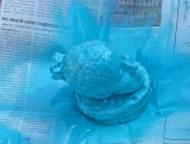Project 7 Bas-relief. Tests
- Marina WitteMann
- Sep 28, 2020
- 2 min read
Autumn has come, so I started my experiments on this topic. Autumn still life.
The new technique sucked me in. I did not expect that prints on clay would be rendered so poetically, sensitively and elegantly in plaster.

My first experiment was immediately successful in terms of the proportions of gypsum and water and the selected sample materials. I guessed the consistency of plaster, so after two/three hours, the relief could be separated, from the clay. Unfortunately, in subsequent tests, I made a mistake. I decided to watch educational videos on working with plaster, so after I started using these tips, everything was terrible. I poured water into the gypsum powder, so I more correctly calculated the volume for the material. Later, adding gypsum to the water, turned out to be too much of this mass and it was very liquid. Therefore, about three planned works crumbled.
While working with the composition itself, the first thing I thought about was volume. How deep do I need to create a relief, so that objects are separated and at the same time in the opposite way (negative and positive impression in plaster).
The second thing that interested me was the borderline place of the relief between the painting and the sculpture. That is, it is no longer a plane with a flat image, but a combination, a mix. For example, the phone was completely recreated in full size. Therefore, we can assume that the sculpture of the phone is embedded in the relief on one side.
In the casting process, the stages of work are clearly distinguished. Preparatory work, including frame construction and preparation of materials. Working with clay. A subtle, analytical process where you need to verify the composition, think about volume and work with your hands. Casting. A simple step, the most important thing is to train with proportions. The final stage, finalization of the form, painting, decoration if needed.
In the first work, since it was a test, I decided to try to paint the material and see how the relief would change. As a result, colour can change the perception of relief. And then I thought, what if the silhouette of a relief differs from the drawing? This is how the idea for my first relief was born.
I tried to make a round shape. But both of my attempts were unsuccessful. Firstly, the wrong kneading, and secondly, the wrong shape of the round material.


In parallel, I continued to experiment with plaster and understood how to create a circle. I could wrap gypsum in material or foil.
I also tried freeform plaster. And I was curious to see what would happen if you fill me with objects. This experience was very interesting because the screws and nails were frozen with the material and I had to clean them from the plaster, look for them and then remove layer by layer. I felt like an archaeologist, who retrieves precious dinosaur remains from the ground.
I copy the 3D shape. A statue of Caesar came to mine mind first.
In fact, it was the unfolding of the sculpture. Sculpture can be drawn and it will be flat, and now, I'm making a relief.
The parts have changed so much that it becomes difficult to recognize Caesar.






























Commentaires